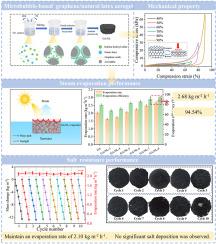Microbubble-based elastic graphene aerogel for efficient solar-driven interfacial evaporation
IF 6.3
2区 材料科学
Q2 ENERGY & FUELS
引用次数: 0
Abstract
Solar-driven interfacial evaporation has emerged as one of the most promising solutions to address the shortage of freshwater resources. Graphene aerogels (GAs) exhibit immense potential in solar-driven interfacial evaporation due to their excellent photothermal conversion efficiency. However, the complex fabrication and inherent fragility of conventional GAs limit their application in desalination. To address these challenges, this study incorporates natural latex (NL) into GA to prepare a novel elastic GA/NL. It uses a gas bubbles and ice crystals templating method followed by atmospheric-pressure drying. The prepared GA/NL achieves a compressive strength of 66.9 kPa at 90 % strain. Its three-dimensional interconnected porous network structure contributes to high porosity (∼ 97 %) and an average light absorbance of 93.3 %. Experimental determination exhibits an outstanding evaporation rate of about 2.68 kg m−2 h−1 and a solar-vapor conversion efficiency of 94.54 % under 1 sun irradiation (1 kW m−2). Critically, GA/NL exhibits excellent stability of structure, salt resistance, and high desalination performance after ten evaporation cycles. These results indicate excellent mechanical properties for long-term desalination application, highlighting its exceptional potential as an efficient, durable interfacial solar steam generator.

基于微泡的弹性石墨烯气凝胶,用于高效的太阳能驱动界面蒸发
太阳能驱动的界面蒸发已经成为解决淡水资源短缺的最有希望的解决方案之一。石墨烯气凝胶由于其优异的光热转换效率,在太阳能驱动的界面蒸发中表现出巨大的潜力。然而,传统气体的复杂制造和固有的脆弱性限制了它们在海水淡化中的应用。为了解决这些问题,本研究将天然乳胶(NL)掺入GA中,制备了一种新型弹性GA/NL。它采用气泡和冰晶模板法,然后采用常压干燥法。制备的GA/NL在90%应变下抗压强度达到66.9 kPa。其三维互连的多孔网络结构有助于高孔隙率(~ 97%)和平均吸光率为93.3%。实验结果表明,在1次太阳照射(1 kW m−2)下,蒸发速率约为2.68 kg m−2 h−1,太阳-水蒸气转换效率为94.54%。关键是,GA/NL在10次蒸发循环后表现出优异的结构稳定性、耐盐性和高脱盐性能。这些结果表明其具有良好的机械性能,可用于长期的海水淡化应用,突出了其作为高效、耐用的界面太阳能蒸汽发生器的特殊潜力。
本文章由计算机程序翻译,如有差异,请以英文原文为准。
求助全文
约1分钟内获得全文
求助全文
来源期刊

Solar Energy Materials and Solar Cells
工程技术-材料科学:综合
CiteScore
12.60
自引率
11.60%
发文量
513
审稿时长
47 days
期刊介绍:
Solar Energy Materials & Solar Cells is intended as a vehicle for the dissemination of research results on materials science and technology related to photovoltaic, photothermal and photoelectrochemical solar energy conversion. Materials science is taken in the broadest possible sense and encompasses physics, chemistry, optics, materials fabrication and analysis for all types of materials.
 求助内容:
求助内容: 应助结果提醒方式:
应助结果提醒方式:


